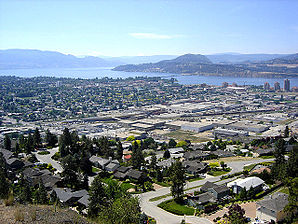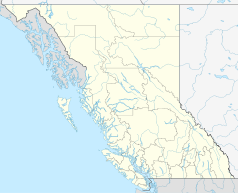Kelowna
| Kelowna | ||
|---|---|---|
 View of Kelowna and Lake Okanagan |
||
 flag |
||
| Location in British Columbia | ||
|
|
||
| State : |
|
|
| Province : | British Columbia | |
| Regional District : | Central Okanagan | |
| Coordinates : | 49 ° 53 ′ N , 119 ° 27 ′ W | |
| Height : | 344 m | |
| Area : | 211.69 km² | |
|
Inhabitants : - Metropolitan Area : |
117,312 (as of 2011) 179,839 (as of 2011) |
|
| Population density : | 554.2 inhabitants / km² | |
| Time zone : | Pacific Time ( UTC − 8 ) | |
| Postal code : | V1P - V1Z | |
| Mayor : | Walter Gray | |
| Website : | www.kelowna.ca | |
 sunset |
||
| Climate diagram | ||||||||||||||||||||||||||||||||||||||||||||||||
|---|---|---|---|---|---|---|---|---|---|---|---|---|---|---|---|---|---|---|---|---|---|---|---|---|---|---|---|---|---|---|---|---|---|---|---|---|---|---|---|---|---|---|---|---|---|---|---|---|
| ||||||||||||||||||||||||||||||||||||||||||||||||
Kelowna [ kəˈloʊnə ] is the largest city on Lake Okanagan in British Columbia , Canada , with a population of almost 120,000 . It was first settled by missionaries in 1859 and officially received city rights in 1905. The city is the eighth largest in British Columbia and 43rd in all of Canada. In 2003, extensive forest fires destroyed more than 200 houses and around 30,000 people were evacuated at times. However, large parts of the destroyed area have already been rebuilt. Much of the historic Kettle Valley Railway was destroyed during the 2003 fire. Parts of the route are already intact or under construction.
Geography and climate
Kelowna is about 400 km east of Vancouver and about 130 km north of the border with the United States. The city is located on the eastern shore of Lake Okanagans , east of the city is the Okanagan Highlands.
Kelowna has a very mild, semi-arid climate. The average temperatures over the year range between −7 ° C and 28 ° C. In winter there is little snow (average snow depth in January is 13 cm), the most frequent snowfalls are mainly to be expected in December and January. The official Kelowna weather station is located at the local Kelowna Airport . Summers are characterized by hot and dry phases, often with daytime temperatures above 30 ° C. The highest temperature ever recorded was 39.5 ° C on July 24, 1994, the lowest -36.1 ° C on December 30, 1968. During the summer it is often sunny and there is only sporadic precipitation. However, nighttime temperatures can drop very sharply. Most rainfall occurs in June; however, there is usually drought throughout the summer, which can sometimes lead to forest fires.
Demographics
The 2011 census showed the city had a population of 117,312. The population increased by 9.6% compared to the 2006 census, while the population in British Columbia only grew by 7%. The cost of houses and apartments has increased by around 50% since 1995 due to strong growth.
Economy and Infrastructure
economy
Kelowna's economy is heavily influenced by the service industry. In the greater Kelowna area, over 75% are employed in this sector. In addition, Kelowna is a popular tourist destination. In summer there are offers for sports enthusiasts in the areas of sailing, golf, hiking and mountain biking, in winter Kelowna is popular because of the winter sports areas southwest of the city.
One of the largest wine-growing regions in Canada is located on Lake Okanagan, benefiting from the mild climate. Therefore, there are also numerous wineries in Kelowna. The wine-growing areas are outside south and west of the city.
Compared to the rest of Canada, Kelowna has seen above-average growth. Between 1996 and 2006 the population grew by 19.3%, while the whole of British Columbia only grew by 9.5%. The city has been trying for some time to gain a foothold in the high-tech sector . However, most of the resident companies are very small (up to 10 employees). For this reason, Kelowna joined forces with other cities on the Okanagan to create the "Accelerate Okanagan".
education
schools
In Kelowna and Okanagan there are 32 public schools from kindergarten / elementary school to grade 12 ( high school ). The schools are subordinate to School District 23 Central Okanagan. There are also other French-speaking and private schools in the city.
Colleges
Okanagan College and the University of British Columbia Okanagan are the largest higher education institutions in the city. Okanagan College has approximately 5000 students enrolled in multiple fields. The college allows access to a university. The University of British Columbia Okanagan has around 6,000 students enrolled in various bachelor and master degrees.
Sports
The Kelowna Rockets ice hockey team , which plays in its own large stadium in the city, is of great sporting importance for Kelowna . Other sports teams include the Okanagan Challenge in soccer , the Kelowna Falcons in baseball , and the Okanagan Sun in Canadian football , the Canadian version of American football .
traffic
Road traffic
For several years only one major highway, Highway 97 , ran through the city. This connects the city with the nationally important highways such as the important east-west connections Trans Canada Highway and Crowsnest Highway . The Coquihalla Highway, the shortest connection to Vancouver , is reached via Highway 97C, which branches off from Highway 97 in Peachland. The Highway 33 branches in the city center of Highway 97 to the east, and so opens up the big ski resorts east of Kelowna.
Since the official opening on May 25, 2008, Kelowna has been linked to Kelowna West by a new five-lane bridge, the William R. Bennett Bridge . The old floating bridge from 1958, which was one of the largest in the world, but could no longer handle the increasing traffic, was demolished a short time later. Some parts of the bridge were preserved as memorials near the shore.
Transportation
The city's public transport is operated by a Scottish transport company, the FirstGroup . The company operates several bus services within Kelowna and the neighboring cities. Local transport is financed by the City of Kelowna, the Regional District of Central Okanagan , the District of Lake Country and BC Transit.
Flight connections
Kelowna Airport is of supraregional importance . The Kelowna International Airport is located north of downtown and is the tenth largest airport in Canada, as measured by the number of passengers. There are scheduled connections to several destinations in Canada such as to and from Calgary , Edmonton , Toronto , Vancouver , Victoria and Seattle . There are also seasonal connections to Las Vegas , Phoenix and Mexico .
Twin cities
sons and daughters of the town
- Donald Arnold (* 1935), rower
- Gillian Bakker (* 1969), triathlete
- Kyle Beach (born 1990), ice hockey player
- Bill Bennett (1932–2015), politician and entrepreneur
- Troy Bigam (* 1975), German-Canadian ice hockey player
- Steve Bozek (* 1960), ice hockey player
- Jason Deleurme (born 1977), ice hockey player
- Jonathan Filewich (* 1984), ice hockey player
- Lea Foli (* 1933), violinist and music teacher
- Josh Gorges (* 1984), ice hockey player
- Taylor Kitsch (* 1981), film and television actor
- Conrad Leinemann (* 1971), beach volleyball player
- Ken Magowan (born 1981), ice hockey player
- Jared Lowell Miller (* 1969), ancient orientalist
- Julia Ransom (* 1993), biathlete
- Justin Schultz (* 1990), ice hockey player
- Kelsey Serwa (* 1989), freestyle skier
- Garth Stevenson (* 1982), jazz musician and film composer
- Doug Stienstra (* 1976), Dutch-Canadian ice hockey player
- Dustin Sylvester (* 1989), ice hockey player
- Cody Sylvester (born 1992), ice hockey player
- Jackson Whistle (born 1995), ice hockey player
Web links
- Official website of the City of Kelowna
- General tourism site about Kelowna
- Accelerate Okanagan OSTEC
Individual evidence
- ↑ a b BC Stats: British Columbia Municipal Census Populations, 1921-2006 ( Memento of the original from August 1, 2012 in the web archive archive.today ) Info: The archive link was automatically inserted and has not yet been checked. Please check the original and archive link according to the instructions and then remove this notice.
- ↑ City of Kelowna: Location map
- ^ National Climate Data and Information Archive: Kelowna
- ↑ Statistics Canada (2011 Census). Kelowna City Profile , accessed July 5, 2012
- ^ BC Stats: Employment by Industry - Metropolitan Areas
- ↑ BC Stats: BC Annual Population, 1931-2010 ( Memento of the original from January 14, 2012 in the Internet Archive ) Info: The archive link was inserted automatically and has not yet been checked. Please check the original and archive link according to the instructions and then remove this notice.
- ↑ Statistics Canada: Passengers enplaned and deplaned on selected services - Top 50 airports


